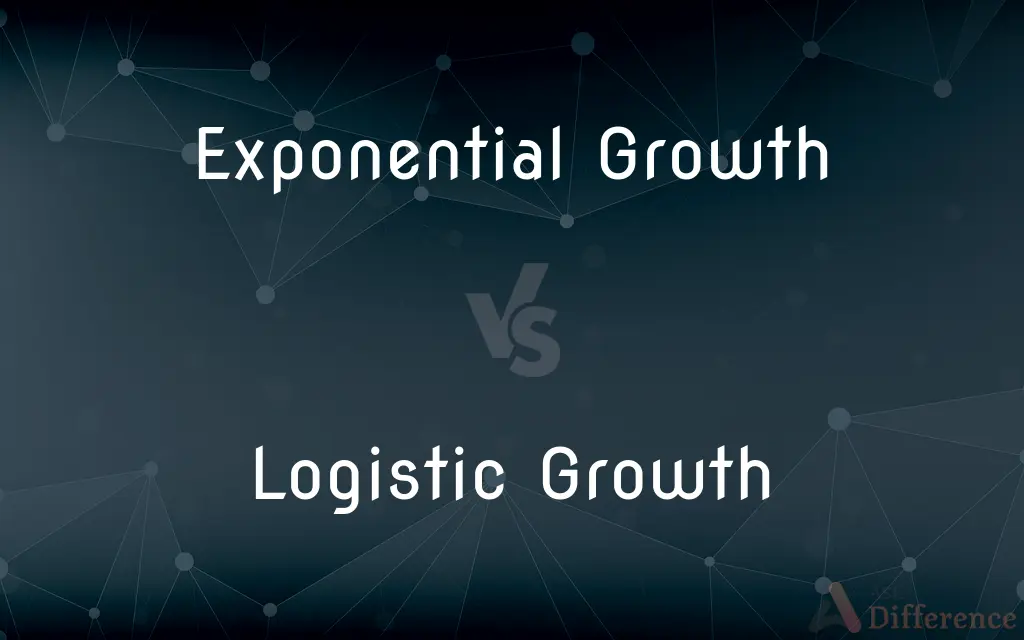Exponential Growth vs. Logistic Growth — What's the Difference?
Edited by Tayyaba Rehman — By Fiza Rafique — Published on January 10, 2024
Exponential Growth refers to unchecked growth at a constant rate, while Logistic Growth factors in resource limitations, leading to growth saturation.

Difference Between Exponential Growth and Logistic Growth
Table of Contents
ADVERTISEMENT
Key Differences
Exponential Growth is characterized by a growth pattern where the rate of growth is proportional to the current value, leading to an ever-increasing, explosive growth. In such scenarios, populations or values double in size or amount over consistent intervals. In contrast, Logistic Growth introduces the concept of a carrying capacity, suggesting that growth will not continue indefinitely but will stabilize once resources become limited.
In the realm of biology, Exponential Growth would imply that a population is growing in an environment where there are no constraints on resources or space. This can be visualized as a steep, upward-sloping curve on a graph. Logistic Growth, however, takes into account limitations in resources. As a population nears its carrying capacity, the growth rate slows and eventually levels off, producing an S-shaped curve.
From a mathematical perspective, Exponential Growth can be described by a simple equation where growth is a function of a constant rate times the current value. Logistic Growth, on the other hand, involves a more complex equation that incorporates the carrying capacity and the effect it has on slowing down growth as the population or value approaches this limit.
When examining real-world phenomena, Exponential Growth can sometimes be observed in cases like the spread of a virus in a susceptible population or the growth of money through compound interest. However, in most natural scenarios, especially with living populations, Logistic Growth is more realistic because resources like food, space, or nutrients are finite.
In economic contexts, Exponential Growth might refer to unchecked economic growth or the rapid growth of a particular sector or company. Meanwhile, Logistic Growth might describe the growth of a market that eventually becomes saturated as it reaches its potential or maximum size.
ADVERTISEMENT
Comparison Chart
Growth Pattern
Constant and unchecked
Limited by carrying capacity
Curve Shape
J-shaped
S-shaped
Influencing Factors
Growth rate alone
Growth rate and resource limitations
Long-Term Behavior
Continues indefinitely
Stabilizes at carrying capacity
Real-World Examples
Compound interest, viral spread
Population growth with limited resources, market saturation
Compare with Definitions
Exponential Growth
Growth whose rate is proportional to its current value.
Compound interest demonstrates Exponential Growth as the amount grows proportionally to its current size.
Logistic Growth
Growth influenced both by its inherent rate and external constraints.
A farmer's crop yield might display Logistic Growth due to soil nutrient limitations.
Exponential Growth
A rapid increase characterized by doubling intervals.
The unchecked spread of rumors on social media can follow an Exponential Growth pattern.
Logistic Growth
A pattern where growth slows as it approaches its carrying capacity.
The adoption rate of a new technology might follow Logistic Growth as the market becomes saturated.
Exponential Growth
A J-shaped curve when visualized on a graph.
When charting the growth of a startup company in its early days, one might see an Exponential Growth curve.
Logistic Growth
An S-shaped curve when represented graphically.
Studying the growth of fish in a pond over time, one might observe a Logistic Growth curve.
Exponential Growth
A growth pattern unaffected by external limitations.
In a petri dish with unlimited resources, bacteria might exhibit Exponential Growth.
Logistic Growth
Growth that considers resource limitations, leading to saturation.
In nature, most animal populations exhibit Logistic Growth due to limited food and space.
Exponential Growth
An unchecked growth pattern that continues indefinitely.
In the early stages of an epidemic, a virus may show Exponential Growth among a susceptible population.
Logistic Growth
A balance between growth drivers and growth constraints.
Urban city expansion can sometimes show Logistic Growth due to space and infrastructure constraints.
Common Curiosities
How does carrying capacity influence Logistic Growth?
It acts as an upper limit, slowing growth as the value or population approaches this threshold.
Are human populations currently experiencing Exponential Growth or Logistic Growth?
While historically there were phases of Exponential Growth, current trends suggest more Logistic Growth patterns due to resource constraints.
Can a population in nature sustain Exponential Growth indefinitely?
No, due to limited resources, natural populations typically shift from Exponential to Logistic Growth.
Can economies display Exponential Growth?
In short bursts, yes, but long-term Exponential Growth is unsustainable due to resource and market limitations.
What primarily differentiates Exponential Growth from Logistic Growth?
Exponential Growth is constant and unchecked, while Logistic Growth factors in resource limitations.
Can an environment's carrying capacity change?
Yes, due to factors like resource availability, environmental conditions, and technological advancements.
Is Logistic Growth more realistic in real-world scenarios?
Generally, yes, as most systems have some form of constraint or limitation.
Why is the Logistic Growth curve S-shaped?
It starts off steep (like Exponential Growth) but flattens as it approaches the carrying capacity.
Is the growth of technology and innovation Exponential?
Some argue certain technologies follow Exponential Growth, but market saturation and other factors might make it more logistic over time.
How do the growth equations differ between Exponential and Logistic Growth?
Exponential Growth uses a simple multiplier, whereas Logistic Growth's equation factors in the carrying capacity.
Do companies typically experience Exponential or Logistic Growth?
While startups might initially see Exponential Growth, most companies transition to Logistic Growth as markets become saturated.
In what scenario is Exponential Growth most commonly observed?
In systems or contexts with minimal limitations, such as certain financial models or early stages of uncontrolled phenomena.
Can a species exceed its carrying capacity?
Temporarily, yes, but this often leads to a sharp decline or crash due to resource depletion.
Why is it important to understand the difference between Exponential and Logistic Growth?
Understanding these growth types helps in predicting future trends, making informed decisions, and planning for sustainability.
What might cause a shift from Exponential to Logistic Growth?
Factors like limited resources, competition, or environmental changes can trigger this shift.
Share Your Discovery

Previous Comparison
Prokaryotic DNA Replication vs. Eukaryotic DNA Replication
Next Comparison
Muay Thai vs. Thai boxingAuthor Spotlight
Written by
Fiza RafiqueFiza Rafique is a skilled content writer at AskDifference.com, where she meticulously refines and enhances written pieces. Drawing from her vast editorial expertise, Fiza ensures clarity, accuracy, and precision in every article. Passionate about language, she continually seeks to elevate the quality of content for readers worldwide.
Edited by
Tayyaba RehmanTayyaba Rehman is a distinguished writer, currently serving as a primary contributor to askdifference.com. As a researcher in semantics and etymology, Tayyaba's passion for the complexity of languages and their distinctions has found a perfect home on the platform. Tayyaba delves into the intricacies of language, distinguishing between commonly confused words and phrases, thereby providing clarity for readers worldwide.















































